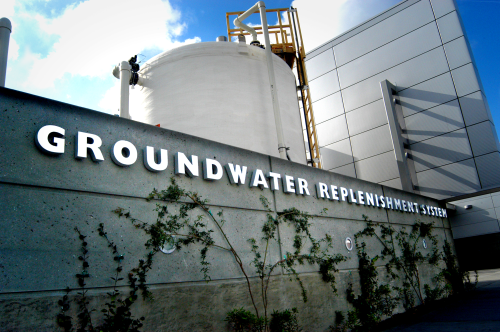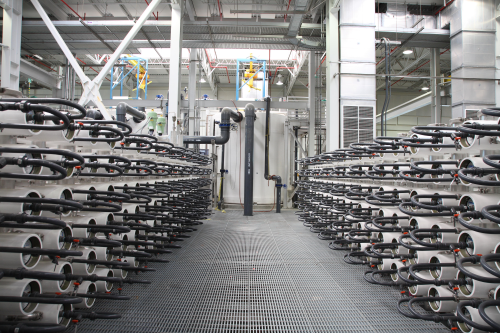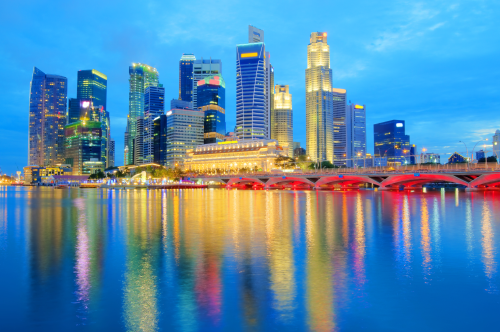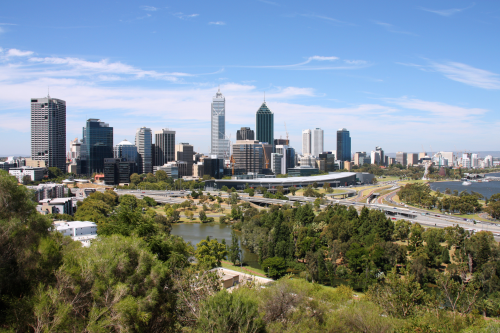



Hybridisation techniques can be applied to power generation and water purification systems to increase both water security and energy efficiency. This article explains how converting off peak electricity or utilising renewable energy supplies and converting these power sources into valuable fresh groundwater for future use can be viewed as a means of storing energy. Two projects are described where alternative water sources have been used for groundwater replenishment in California, USA (265 MLD) and for surface water reservoir recharge in Singapore (228 MLD), for subsequent indirect potable use. Also, a smaller scale project in the UK (1.25 MLD) is briefly highlighted where treated effluent is supplied directly to a local power station as high-purity water. A summary of projects currently in the design phase is included and, in conclusion, challenges for future development are presented.
Alternative water sources
With increasing population growth and changing weather patterns due to the effects of climate change, the need to find additional and alternative sources of water is more pressing than ever on a global scale. Alternative sources of water are those which have not been significantly exploited yet, due to the need for advanced technology to remove organic and inorganic pollutants and toxins. Examples include highly turbid river water or secondary treated effluent as opposed to, for example, water already treated to potable quality by a municipal water supply company. Alternative sources are currently used for indirect potable applications, ultrapure processes or high purity water applications in manufacturing industry or power generation.
Opportunities for increasing environmental sustainability can be overlooked by concentrating on the separate applications of water and wastewater treatment without considering the whole hydrological cycle, which needs to be managed in an integrated manner so we avoid focusing on these disciplines as if they were unrelated subjects. However, the benefits of utilising alternative water sources, identified by Durham [1], have become better understood over the last decade.
The responsibility for the management and control of water consumption throughout the hydrological cycle rests with local governments, agencies and their regulators. Their priorities are to reduce waste, demand, leakage and evaporation losses and maximise water management efficiency.
At the large-scale, we can think of the hydrological cycle as evaporation from sea and land, forming clouds and then water falling to Earth as precipitation, being collected in rivers and entering the sea again before being intercepted for potable use and discharged from municipalities as treated effluent. We can shrink the cycle and just think of the local perspective, with treated wastewater being recycled into potable water in adjacent treatment plants, or planned indirect potable use of wastewater, where treated wastewater is used to replenish groundwater. The groundwater is then used as a potable water source.
Often, we find power generation facilities located on the outskirts of cities along with wastewater treatment facilities and potable water treatment systems. We could consider using alternative sources of water for cooling and process water in the power station rather than using expensive potable water. But this requires us to be able to manage the hydrological cycle for the city as a whole. If we were able to integrate power generation and water treatment processes as a single management activity, we could focus on various benefits including reduced aqueous pollution into receiving waters and retention of high quality water for potable supply. Reusing water from alternative sources can be used as a catalyst to help understanding of the hydrological cycle as a whole.
Hybridisation
In a city-wide water management plan, the efficiency of power generation systems could be increased by reducing the inefficient period which occurs during periods of low demand such as during the night or in the summer months. This unused power generation capacity could be used to increase water treatment rates if there is sufficient water demand or storage capacity. Also, any surplus energy generated from intermittent renewable sources, such as wind or solar voltaic systems, during periods of low demand and high production could be directed towards water treatment processes.
Hybridisation could be used to exploit this unused capacity as part of a comprehensive water management plan. Hybridisation is an approach to increase the efficiency of an overall system by taking advantage of the synergy between different process solutions.
In the case of treating wastewater for planned indirect potable use, demand periods would tend to vary on diurnal cycles. During the low demand period, water could be ‘banked’ into groundwater or reservoir storage at a high rate to create fresh water aquifers in brackish or saline zones, or supplement surface water supplies. Also, where appropriate this could help control seawater ingress due to over abstraction of groundwater or, in the future, help combat rising seawater levels due to climate change. We can argue that we could effectively convert unsold off peak electricity or excess renewable production into valuable fresh groundwater in the low demand period, for future use in the high demand period, hence effectively storing energy and using the groundwater or reservoir ‘bank’ like a battery.
Indirect potable water production technology
Two large indirect potable water projects are described where microfiltration (MF), ultrafiltration (UF), reverse osmosis (RO) and post-treatment technologies have been used to reduce total suspended solids (TSS), total dissolved solids (TDS) and organic and inorganic pollutants in process systems with similar characteristics.
The projects outline the way in which alternative water sources can be utilised around the globe for replenishing groundwater or surface water reservoirs. We look at two large-scale municipal projects and investigate how water banking is used in the USA, and how similar technology is used in Singapore to reduce the pressure on traditional potable water sources.
California's Groundwater Replenishment System
The Groundwater Replenishment System (GWRS, see Figure 1) takes highly treated wastewater that would have previously been discharged into the Pacific Ocean and purifies it using a three-step advanced treatment process consisting of MF, RO and ultraviolet (UV) light with hydrogen peroxide. The process produces high quality water that exceeds all Californian and US federal drinking water standards, water that is used to replenish groundwater reserves and increase the supply of lower saline sources for subsequent potable water production, irrigation and agriculture.
Operational since January 2008, this advanced water purification project can produce up to 265 MLD of high quality water, enough, when treated further, to meet the needs of nearly 600,000 residents in north and central Orange County, California.
The design and construction of the GWRS was a project jointly funded by the Orange County Water District and the Orange County Sanitation District (OCSD). These two public agencies have worked together for more than 30 years, previously on the Water Factory 21 project that led to the development of the GWRS.
Water used in the GWRS is first treated at OCSD, which collects more than 757 MLD of wastewater and removes a high degree of impurities through several processes. A stringent source control program limits metals and chemicals flowing into OCSD's plants in the Fountain Valley and Huntington Beach areas. The wastewater undergoes treatment through bar screens, grit chambers, trickling filters, activated sludge, clarifiers and disinfection processes before it is sent to the GWRS. It is vital that the water meets the necessary water quality standards before further treatment in the GWRS.
Following treatment by MF and RO in the GWRS, the treated wastewater is exposed to high intensity UV light with hydrogen peroxide (H2O2) to disinfect and to destroy any trace organic compounds that may have passed through the RO membranes (see Figure 2). Examples of these trace organic compounds are N-Nitrosodimethylamine (NDMA) and 1–4 Dioxane, which have to be removed to the parts-per-trillion level. UV with H2O2 provides an effective disinfection/advanced oxidation process that eliminates these compounds from entering the groundwater and being utilised in drinking water supplies.
Singapore NEWater Project
The Singapore Water Reclamation Study was initiated in 1998 by the Singapore Public Utilities Board (PUB) to determine the suitability of using high-purity water as an alternative source of raw water to supplement Singapore's water supply. The treated NEWater (the high quality water) meets the USA Environmental Protection Agency and World Health Organisation drinking water standards. It is also produced from secondary treated effluent using MF, RO and UV.
Following extensive pilot testing, full scale NEWater Factories at Bedok and Kranji Water Reclamation Plants were commissioned in 2002. The largest plant at Kranij was designed to initially treat 40 MLD with a capacity to expand to 72 MLD in the future.
Since February 2003, NEWater water has been supplied to industries for non-potable use in power generation and other applications. In 2004, the third NEWater Factory at Seletar was commissioned, which began supplying NEWater to the microelectronics industry, being used directly in wafer fabrication plants at Ang Mo Kio.
The recent addition of the Sembcorp NEWater Plant marks a major step in Singapore's water sustainability activities with its total capacity increasing significantly to 228 MLD, a similar capacity to the GWRS in California. NEWater is now able to meet 30% of Singapore's total water demand with the majority of the NEWater supplementing surface water reservoirs.
The contract for the latest NEWater facility was awarded to Sembcorp in January 2008 by PUB under a public-private partnership initiative. The project was engineered in two phases over a two-year period. The initial phase of the plant, producing 69 MLD, began operations in 2009.
This was the second and largest NEWater plant to be designed, built, owned and operated by the private sector, while PUB owns another three plants. This new plant uses the same established and proven NEWater technology pioneered by PUB. NEWater from this plant meets the same high stringent quality standards as those from the other NEWater plants.
Flag Fen Project
A smaller scale project in the UK has been described by Murrer [4]. This re-use system has been in operation for nearly a decade and incorporates MF and RO technology with municipal effluent used as an alternative source, processed into high purity water for feeding directly into Texas Utilities' Peterborough Power Station (PPS). The station is located adjacent to Flag Fen Sewage Treatment Works. ACWA Services Limited built and installed the plant, and commissioned the system in 2000.
Judd & Jefferson [3] advised that the RO plant exceeded the contractual water qualities with permeate quality at typically 39 μS/cm (compared to the 60 μS/cm specified). RO permeate quality water enabled demineralised water production at PPS to increase by 20% and a reduction of over 90% in the costs of ion exchange regeneration has been realised. 1.25 MLD of potable water is saved which reduced PPS's total water usage by 11%.
Whilst the Flag Fen project is not on the same throughput scale as the GWRS or NEWater systems, it does show us that the demand on potable water supply can be reduced by industries utilising alternative sources of water directly, using proven advanced filtration and separation technology. The geographical location of PPS and Flag Fen sewage treatment works was a main driver for the project. But the opportunity for synergies and hybridisation were limited due to the type of power station.
New projects
Following the pioneering work described on the indirect use of treated secondary effluent for potable use, a new groundwater replenishment research project is underway in Perth, Australia. Groundwater replenishment using recycled water is one of several options for future water sources being considered by the local municipal water supply company, called ‘Water Corporation’.
While planning estimates indicate it could provide up to 20 per cent of Perth's future water needs, a decision has not yet been made to introduce any future groundwater replenishment schemes. Water Corporation started a research trial in 2010 that will be concluded at the end of 2012 to assess the effectiveness of the advanced water recycling process in producing water that is as safe as drinking water. If this trial is successful (which is likely given the experiences described) and the community is supportive, water recycled through this process could become a major water source for Western Australia (WA) in the next decade. The trial is being overseen by the WA Department of Health, WA Department of Water and WA Department of Environment and Conservation, and is part-funded by the Australian Government's ‘Water for the Future’ initiative.
Other notable projects being considered are in the US – the San Diego Water Authority and Helix Water District, and the Los Angeles Water Replenishment District (Upper San Gabriel Valley, West Basin Water District).
Conclusion
We have suggested that comprehensive water management, which examines the water cycle as a whole, is required to make the most effective overall use of alternative water sources. In addition, there is the need to reduce waste, demand, leakage and evaporation losses, so we can maximise water management efficiency.
The GWR System and NEWater plants described provide excellent examples of how alternative water sources can be used on a municipal scale to expand potable water supplies and reduce the pressure on traditional raw water sources. Filtration and separation technology for the treatment of secondary effluent is now well proven and consistently high-quality high-purity water can be produced. Future projects can be envisaged where similar systems can become integrated with power generation systems to provide cooling, process and freshwater for banking and storage when required. This would make use of hybridisation in the selection of process technologies, reducing the overall energy requirement and environmental impact of a municipality by making full use of generation capacity during periods of low power demand and high renewable energy production.
The challenge is for the development of integrated solutions at the municipal scale where both water efficiency and energy efficiency can be maximised whilst maintaining security of potable water supply.
References and further information
1 B Durham, Reuse and desalination – the drivers, benefits and future needs, Desalination & Water Re-Use, Faversham House Group Limited, UK (December 2003) (2003).
3 SJ Judd and B Jefferson, Membranes for industrial water recovery and reuse, Elsevier Science Limited, UK (2004).
4 J Murrer, Converting sewage effluent into high purity process water, Filtration + Separation, Elsevier Science Limited, UK (2002) May 2002.
Uncited references, Ground Water Replenishment System, Orange County, US www.gwrsystem.com.
, NEWater, Public Utilities Board, Singapore www.pub.sg/newater.
, Water Corporation, Perth, Australia www.watercorporation.com.au.






